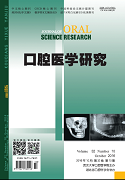|
|
An Analysis of Influential Factors on MRI Artifacts of Oral Non-precious Metal Prosthesis.
CHEN Yi, LI Hui, WANG Li-yan, LIU Gang, FAN Xin-hao, HUI Xin-yu .
2016, 32(10):
1024-1027.
DOI: 10.13701/j.cnki.kqyxyj.2016.10.006
Objective: To investigate influential factors on MRI artifacts of oral non-precious metal prosthesis. Methods: Two kinds of non-precious metal dental materials (Ni-Cr alloy and Co-Cr alloy) were molded into standard post-core-crown models as experimental group. Acrylic resin post-core-crown with the same size and shape was used as control group. The models were fixed in a water phantom. The Ni-Cr alloy, Co-Cr alloy and acrylic resin post-core-crown models were scanned by 1.5T MR scanner with the head coil. Scanning strategy was as follows: 1) Ni-Cr alloy, Co-Cr alloy and resin posterior teeth were selected, and axial T1WI, T2WI, T2*WI, FLAIR, DWI sequences were scanned respectively. 2) Ni-Cr alloy and Co-Cr alloy posterior teeth were selected, and axial, sagittal, and coronal T1WI, T2WI sequences were scanned respectively. 3) Ni-Cr alloy anterior tooth and posterior teeth were selected, and axial, sagittal, and coronal T2WI sequences were scanned respectively. The section with the greatest artifact was determined and the area was measured. Statistical testing was performed. Results: The sizes of the artifacts in descending order were as follows: Ni-Cr alloy, Co-Cr alloy and acrylic resin post-core-crown (P<0.01). The sizes of the artifacts were different at different sequences, and in descending order were DWI, T2*WI, T2WI, T1WI and FLAIR (P<0.01). The sizes of the artifacts were different at different sections (P<0.01). The artifacts of the posterior teeth were greater than those of the anterior teeth (P<0.01).Conclusion: It is feasible to choose Co-Cr alloy in non-precious metal for its better biocompatibility and less artifacts.
References |
Related Articles |
Metrics
|

